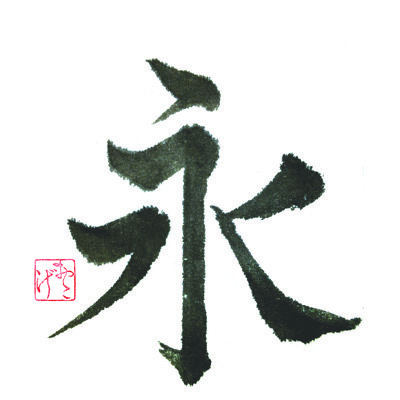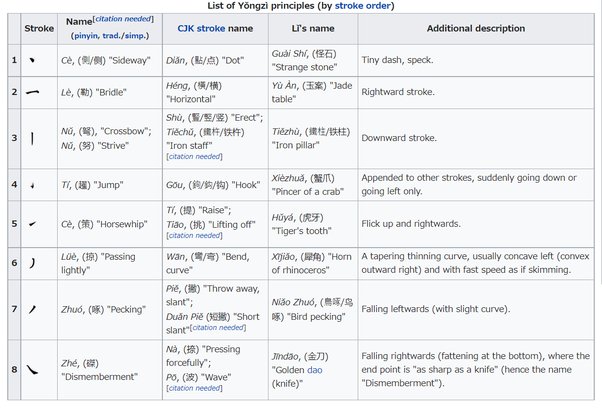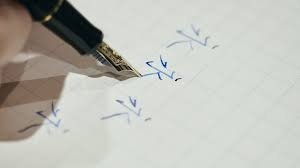It’s 永.

The kanji for “永(ei)”, which means long time, contains all eight techniques necessary for calligraphy.

It’s called 永字八法(eiji happou).

Eight Principles of Yong – Wikipedia
From Wikipedia, the free encyclopedia Demonstration of common strokes in Chinese characters The character 永 , yǒng , “forever”, “permanence” Stroke order animated (left) and in color gradation from black to red (right) The strokes numbered Where there are multiple numbers in an area, the strokes overlap briefly and continue from the previous number to the next. The strokes together, and separated Sequence numbers and stroke directions in red Eight Principles of Yong Chinese 永字八法 The Eight Principles of Yong ( Chinese : 永字八法 ; pinyin : Yǒngzì Bā Fǎ ; Japanese : 永字八法/えいじはっぽう , eiji happō ; Korean : 영자팔법/永字八法 , Yeongjapalbeop ; Vietnamese : Vĩnh tự bát pháp ) explain how to write eight common strokes in regular script which are found all in the one character, 永 ( pinyin : yǒng , “forever”, “permanence”). It was traditionally believed that the frequent practice of these principles as a beginning calligrapher could ensure beauty in one’s writing. The Eight Principles are influenced by the earlier Seven Powers ( 七勢 ) by Lady Wei Shuo ( 衛鑠 ) of Eastern Jin . Publications on the Principles include: Table of naming usages [ edit ] List of Yǒngzì principles (by stroke order ) Stroke Name [ citation needed ] ( pinyin , trad. / simp. ) CJK stroke name Lǐ’s name Additional description 1 Cè , ( 側 / 侧 ) “Sideway” Diǎn , ( 點 / 点 ) “Dot” Guài Shí , ( 怪石 ) “Strange stone” Tiny dash, speck. 2 Lè , ( 勒 ) “Bridle” Héng , ( 橫 / 横 ) “Horizontal” Yù Àn , ( 玉案 ) “Jade table” Rightward stroke. 3 Nǔ , ( 弩 ), “Crossbow”; Nǔ , ( 努 ) “Strive” Shù , ( 豎/竪 / 竖 ) “Erect”; Tiěchǔ , ( 鐵杵 / 铁杵 ) “Iron staff” [ citation needed ] Tiězhù , ( 鐵柱 / 铁柱 ) “Iron pillar” Downward stroke. 4 Tí , ( 趯 ) “Jump” Gōu , ( 鉤/鈎 / 钩 ) “Hook” Xièzhuǎ , ( 蟹爪 ) “Pincer of a crab” Appended to other strokes, suddenly going down or going left only. 5 Cè , ( 策 ) “Horsewhip” Tí , ( 提 ) “Raise”; Tiāo , ( 挑 ) “Lifting off” [ citation needed ] Hǔyá , ( 虎牙 ) “Tiger’s tooth” Flick up and rightwards. 6 Lüè , ( 掠 ) “Passing lightly” Wān , ( 彎 / 弯 ) “Bend, curve” Xījiǎo , ( 犀角 ) “Horn of rhinoceros” A tapering thinning curve, usually concave left (convex outward right) and with fast speed as if skimming. 7 Zhuó , ( 啄 ) “Pecking” Piě , ( 撇 ) “Throw away, slant”; Duǎn Piě ( 短撇 ) “Short slant” [ citation needed ] Niǎo Zhuó , ( 鳥啄 / 鸟啄 ) “Bird pecking” Falling leftwards (with slight curve). 8 Zhé , ( 磔 ) “Dismemberment” Nà , ( 捺 ) “Pressing forcefully”; Pō , ( 波 ) “Wave” [ citation needed ] Jīndāo , ( 金刀 ) “Golden dao (knife)” Falling rightwards (fattening at the bottom), where the end point is “as sharp as a knife” (hence the name “Dismemberment”). Note: - Xié 斜 is sometimes added to the 永 ‘s strokes. It is a concave Shù falling right, always ended by a Gōu , visible on this image. CJK strokes [ edit ] In addition to these eight common strokes in 永 , there are at least two dozen strokes of combinations which enter in the composition of CJK strokes and by inclusion the CJK characters themselves. See also [ edit ] Refer
https://en.wikipedia.org/wiki/Eight_Principles_of_Yong
You use it when you try writing a fountain pen.

It is also used as an example of fountain pen font.
